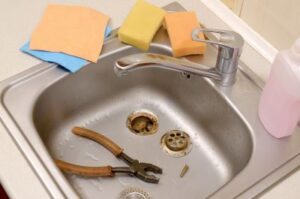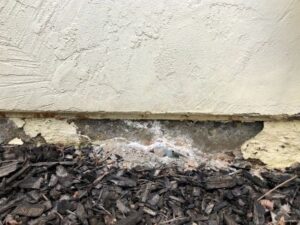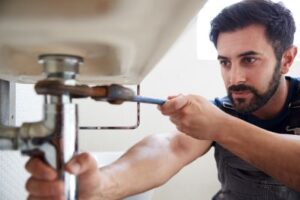How to Fix the Five Most Common Plumbing Problems
Sometimes, you buy a house that needs repairing or renovations. If it is an old house, there are probably some things that need fixing. However, if the problem is with plumbing, there might be serious problems with it. You don’t want to find out after you move in.
Some of the most common issues come from older homes that were not kept up as well as they should have been. However, this can happen with some newer homes too. If you are thinking about buying a new house or renovating an older one, there are certain things to look for to avoid later complications with plumbing.
There are 5 common plumbing problems you may run into when you buy or renovate a home: dripping faucets/toilets, burst pipes, clogged sinks/toilets, slab leaks & slim build-up. I would like to share with you how you can recognize these problems and possibly fix them without a plumber.
Keep reading to learn more!
1. Dripping Faucets & Toilets
A dripping faucet is the most common problem that plumbers deal with and also one of the easiest to fix yourself. A leaky tap can waste a lot of water, which will cost money on your utility bills over time. Fortunately, fixing a leaking faucet doesn’t involve any complicated plumbing skills.
Water drips can be caused by faulty washers or gaskets that need to be replaced. Sometimes the problem might not even be in the fixture itself but somewhere else such as a dripping water heater. When you do see signs of leaky valves, make sure you shut off the main supply before you do any repairs.
Sometimes new homeowners do not realize these problems until the damage is done. Several signs might indicate if there is a problem with leaks such as constant dripping sounds and water stains around the fixtures. Leaking faucets can be fixed easily, but sometimes they cannot be repaired and need to be replaced with new ones.
If you’ve ever had to deal with how much water your household uses on an average day, then you are probably familiar with the feeling of “running out of water.” A leaky faucet or toilet can mean that, in addition to wasting water, you are also wasting money.
Tools Needed
The good news is that fixing a leaky faucet doesn’t require any tools besides an Allen key (which is included with most kits) and screwdrivers of the flat-head type.
If you suspect that one of your taps isn’t working as it should, try tightening the parts that hold it in place with an Allen key. If this doesn’t work, then you might need to replace the washers that are at the end of your faucet’s “stem.”
Toilets can also have leaks around their base, which means they might be leaking into the floor around them. This is a problem because, if left untreated, it can cause serious damage to your home. The best way to fix this is by using a sealant that you can purchase from most hardware stores or even big supermarkets. You don’t need any tools when dealing with a toilet leak except for rubber gloves and towels.
Step 1
Turn off the water supply to your sink. The supply will be either under the sink or on a pipe connected to one of its sides. You can find out by following the pipe from which you suspect the leak is coming and seeing if it leads to a valve that can be “shut off.”
Step 2
Remove the knob or handle on your tap.
Step 3
Unscrew the retaining nuts located under the sink or close to the sides of your tap. These are probably corroded, so be sure to have a wrench on hand in case you need it. Even if they turn out to be loose, just use the wrench for extra leverage while you unscrew them by hand.
Step 4
Pull the stem of your faucet out from its housing. Be careful not to lose the little washers that are probably still there, attached to each end of your stem. The one on the underside of the faucet is called a “packing” washer, and you can buy replacements at almost any hardware store for just a few dollars.
Step 5
Tighten everything that you can reach and then put the washers back in place. This is probably an iterative process, as tightening some parts of your faucet might free up others that were stuck before.
Step 6
Put your knob or handle back on and turn on the water supply. Check for any leaks around where components meet by wiping away excess water with your fingers.
2. Burst Pipes
If the problem is with a pipe that has burst, you will need to shut off the water supply immediately. If you have more than one house member who uses the kitchen, the basement, or any other part of your home that’s connected to your bursting pipe, then it’s important to try to minimize the damage.
When it comes to burst pipes, if your house does not have proper water shut off, then it is time to get one installed. Another thing to look out for are signs of burst pipes from the constant dripping sound of running water. This might be caused by frozen water in the lines which can expand and cause damage.
Burst pipes can lead to many problems such as mold infestation and structural damage if not addressed properly. If you see mud seeping out from under your sink, immediately fill a large bucket with water and place it underneath the pipe.
While you’re doing that, shut off the main valve in your basement or wherever is most convenient. You can turn it back on after giving your puddle time to solidify into a clog that stops the flow of water.
You should also start collecting any absorbent material you can get from around your house, such as old rags and towels. Place them over the mud until it is covered in at least an inch of material so no more water seeps through.
When a pipe is loose, then it is probably because something has shifted in your home. The cause of this can range from a recent construction project to a natural disaster like an earthquake.
If you find yourself faced with a broken pipe, shut off the main valve and call a plumber as soon as possible. You don’t know what might be leaking into your home, and you don’t want to find out.
Sometimes you might hear pipes making strange clanging sounds which could be an indication that there are loose joints, valves, or pipe fittings that need to be tightened up. When this is not done properly, it can lead to damage increasing the risk for leaks.
 3. Clogs In Sinks or Toilets
3. Clogs In Sinks or Toilets
A clogged sink or toilet is another problem that creates a lot of inconvenience for homeowners. It’s also an unpleasant thing to deal with because it means confronting the inevitable result of having too much junk around your house (or at least, not enough dustbins). You might not have the right tools for the job, so it’s important to call a professional for plumbing services.
There might be several causes for slow draining and clogged drains such as a buildup of minerals, hair, and soap scum on the drainage grids which require regular cleaning. Plumbing fixtures can also cause problems such as those with older toilets that have narrow wastes and modern ones with larger drains.
Most clogs in the home will be found in the sinks and tubs, not toilets or drains. However, a blockage or slow-draining toilet can be frustrating and cause problems. Here’s how to fix it:
Step 1
First, check if water is running into the bowl. If it is, flush the toilet and see if it drains. There is no clog if the toilet flushes – you just have to adjust the water level. If not, continue.
Step 2
Fill a 5-gallon bucket with water and pour it into the bowl slowly until it’s about halfway full. If this doesn’t cause any of the water in the bowl to run down, you will need to use a plunger.
Step 3
Use a plunger – it’s the best solution that works most of the time. You can buy plungers at any local hardware store and they’re pretty cheap too.
Step 4
If the toilet is still not empty, you will need to try a plumber’s snake.
What Is A Plumbing Snake?
A plumbing snake, also known as an auger, drain cleaner, or plumber’s helper, has a long flexible cable with a corkscrew end that is used to loosen clogs in drains.
What Is A Drain Cleaner?
Drain cleaners are chemicals that dissolve clogs in your toilet by softening them so they can be removed by the auger or pushed through the drain. If you have a high-quality plumber’s snake, this is usually unnecessary because it will often pull out most smaller clogs.
Step 1
Using your toilet’s instructions, pour the drain cleaner into the clogged toilet bowl.
Step 2
Let it sit for about 30 minutes or according to the manufacturer’s directions.
Step 3:
Flush your toilet and you should have a free-flowing drain. If none of these methods work, it may be time to call a plumber. If you fix the clog yourself, not only will you save money but if the clog would’ve continued to grow then your problem could’ve gotten worse and more expensive for a plumber to fix.
 4. Slab Leaks
4. Slab Leaks
A slab leak is the worst kind of water damage to a house. It can cause extensive damage to your foundation and walls, and lead to mold infestation in the future if not fixed properly.
There are several places in homes where pipes go through the cement slab such as under foundations, garage floors, and laundry rooms. These areas need to be looked at when you buy a house or when you plan on renovating it.
The same goes for the pipes that go through walls or ceilings under the floors. Slab leaks are often undetected since they do not cause visible damage to the house, but there are telltale signs if you just know what to look for.
One way to test for slab leaks is with soapy water. You should find the slab in the areas with pipes under it, where you suspect there might be one. Then, put soapy water on the suspected area and wait for several minutes.
If bubbles form when no one is anywhere near, then this is a possible sign of a leak. Another test that you can do is with smoke pencils or by listening to the sound of running water. You should run all your faucets and listen to the sound of running water. If you hear it, there is a chance it could be the sound of flowing water coming from pipes underneath or under walls or floors.
5. Slime Build Up
If you notice a slimy greenish colored buildup around the base of your bathtub or shower, this usually indicates that there is too much chlorine in the water coming into the fixtures. Sometimes, these deposits are caused by high levels of bicarbonate in the water.

